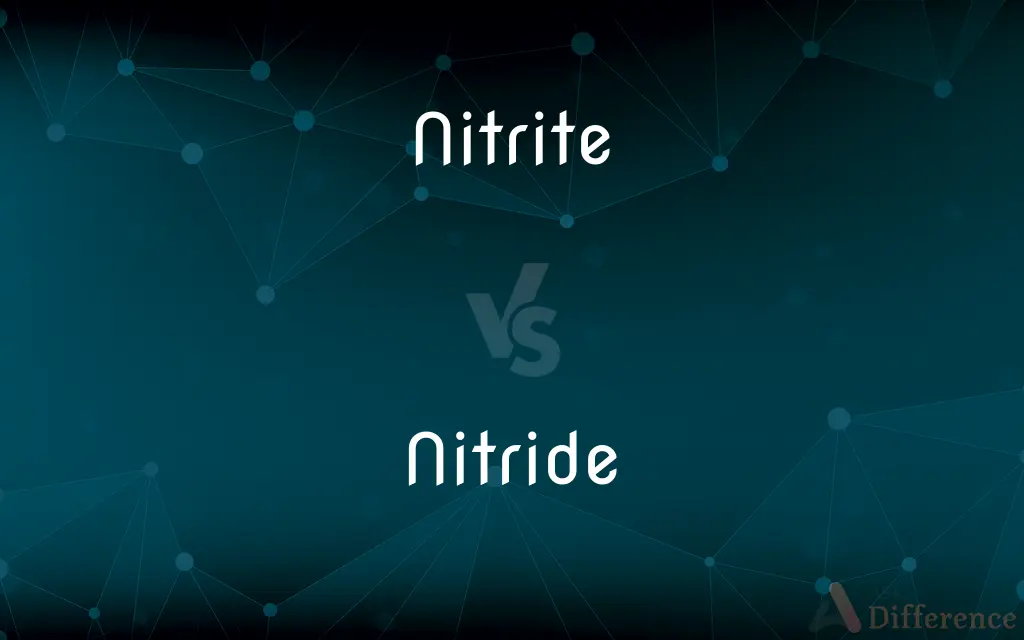Nitrite vs. Nitride — What's the Difference?
Edited by Tayyaba Rehman — By Maham Liaqat — Updated on May 7, 2024
Nitrite (NO2-) is an ion commonly found in salts and solutions, associated with nitrogen oxidation state +3; nitride (N3-) involves nitrogen in a -3 oxidation state, typically in compounds with metals.

Difference Between Nitrite and Nitride
Table of Contents
ADVERTISEMENT
Key Differences
Nitrite, with the chemical formula NO2-, is an ion that forms salts with various metals and occurs in many biological and environmental systems. It is primarily associated with moderate oxidation states of nitrogen. On the other hand, nitride refers to a variety of compounds where nitrogen exhibits a -3 oxidation state, often bonding with metals to form solid compounds like aluminum nitride (AlN).
While nitrites are typically found in aqueous solutions and are a key part of biological nitrogen cycles, participating in processes like nitrification and denitrification, nitrides are generally found as solids and are used in industrial applications due to their hardness, refractory nature, and chemical resistance.
Nitrites play a significant role in environmental chemistry and food preservation, acting as inhibitors of microbial growth in meats and also as intermediates in water purification processes. Conversely, nitrides are valued in materials science, especially in electronics and high-performance ceramics, for their mechanical and thermal properties.
In terms of stability, nitrites are relatively reactive and can be sensitive to heat and changes in pH, often decomposing to form nitric oxide or nitrogen dioxide. Nitrides, however, are typically more thermally stable and chemically inert, making them suitable for high-temperature applications.
Chemically, nitrites are important in medical and physiological contexts as well, where they are involved in vasodilation and blood pressure regulation. Nitrides lack such biological roles but are crucial in technical applications such as the production of hard coatings and advanced electronics.
ADVERTISEMENT
Comparison Chart
Chemical Formula
NO2-
Various, typically X3N
Oxidation State
+3
-3
Typical State
Aqueous solutions, salts
Solid compounds
Role in Biology
Nitrogen cycling, vasodilation
Not biologically active
Industrial Application
Food preservation, water treatment
Electronics, ceramics
Stability
Reactive, sensitive to heat
Thermally stable, chemically inert
Compare with Definitions
Nitrite
Used in food industry as a preservative.
Nitrite inhibits the growth of bacteria in canned foods.
Nitride
Known for high thermal conductivity.
Aluminum nitride is used in heat sinks.
Nitrite
Involvement in medical treatments.
Nitrite compounds are used in treatments for heart conditions.
Nitride
A compound of nitrogen with a more electropositive element.
Boron nitride is used as a lubricant.
Nitrite
Present in biological systems as part of nitrogen cycle.
Nitrite levels are crucial for assessing water quality.
Nitride
Used in making hard ceramic materials.
Silicon nitride is valued for its hardness and thermal stability.
Nitrite
Acts as an intermediate in chemical syntheses.
Nitrite is used in the synthesis of organic compounds.
Nitride
Appears in electronics.
Gallium nitride is used in semiconductor devices.
Nitrite
A salt or ester of nitrous acid.
Sodium nitrite is used in curing meats.
Nitride
Resistant to chemical attack.
Titanium nitride coatings protect cutting tools.
Nitrite
The nitrite ion has the chemical formula NO−2. Nitrite (mostly sodium nitrite) is widely used throughout chemical and pharmaceutical industries.
Nitride
In chemistry, a nitride is a compound of nitrogen where nitrogen has a formal oxidation state of −3. Nitrides are a large class of compounds with a wide range of properties and applications.The nitride ion, N3−, is never encountered in protic solution because it is so basic that it would be protonated immediately.
Nitrite
A salt or ester of nitrous acid, containing the anion NO₂⁻ or the group —NO₂.
Nitride
A binary compound of nitrogen with a more electropositive element.
Nitrite
The univalent anionic group NO2, derived from nitrous acid, or a compound containing this group.
Nitride
Heat (steel) in the presence of ammonia or other nitrogenous material so as to increase hardness and corrosion resistance.
Nitrite
(chemistry) Any salt or ester of nitrous acid.
Nitride
Trivalent nitrogen, or a compound of nitrogen, especially a binary compound of nitrogen with a more electropositive element.
Nitrite
(chemistry) The univalent radical -NO2, and the anion NO2-
Nitride
(chemistry) A compound of nitrogen where nitrogen has an oxidation state of −3. Category:en:Nitrogen
Nitrite
A salt or ester of nitrous acid; a compound bearing the -NO2 radical.
Nitride
(transitive) To subject to the nitriding process.
Nitrite
The radical -NO2 or any compound containing it (such as a salt or ester of nitrous acid)
Nitride
A binary compound of nitrogen with a more metallic element or radical; as, boric nitride.
Nitride
A compound containing nitrogen and a more electropositive element (such as phosphorus or a metal)
Common Curiosities
How do nitrites affect human health?
Nitrites can be beneficial in controlled medical contexts but can be harmful if consumed in high amounts.
Are nitrides reactive?
Generally, nitrides are chemically inert and stable under high temperatures.
What are common uses of nitrites?
Nitrites are used in food preservation and as intermediates in water treatment.
Can nitrides be found naturally?
Nitrides are rarely found naturally and are mostly synthetic.
What is the difference in the chemical behavior of nitrites and nitrides?
Nitrites are more reactive, while nitrides are more stable and inert.
Why are nitrides important in electronics?
Nitrides are used in electronics for their superior thermal and electrical properties.
How do nitrites participate in the nitrogen cycle?
Nitrites are intermediate products in the nitrification and denitrification processes.
What materials are typically used with nitrides in industry?
Metals and silicon, used in ceramics and electronic components.
Are there environmental concerns associated with nitrites?
Yes, excessive nitrites in water can lead to oxygen depletion and affect aquatic life.
What makes nitrides suitable for high-temperature applications?
Their thermal stability and resistance to heat make them ideal for such uses.
Share Your Discovery

Previous Comparison
Hem vs. Seam
Next Comparison
Silence vs. SoundAuthor Spotlight
Written by
Maham LiaqatEdited by
Tayyaba RehmanTayyaba Rehman is a distinguished writer, currently serving as a primary contributor to askdifference.com. As a researcher in semantics and etymology, Tayyaba's passion for the complexity of languages and their distinctions has found a perfect home on the platform. Tayyaba delves into the intricacies of language, distinguishing between commonly confused words and phrases, thereby providing clarity for readers worldwide.
















































